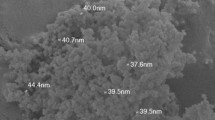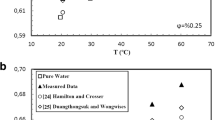Abstract
An experimental investigation was conducted to study the heat transfer and pressure drop characteristics of an array of wavy divergent minichannels and the results were compared with wavy minichannels with constant cross-section. The experiment was conducted in hydro dynamically developed and thermally developing laminar and transient regimes. The minichannel heat sink array consisted of 15 rectangular channels machined on a 30 × 30 mm2 and 11 mm thick Aluminium substrate. Each minichannel was of 0.9 mm width, 1.8 mm pitch and the depth was varied from 1.3 mm at entrance to 3.3 mm at exit for the divergent channels. DI water and 0.5 and 0.8 % concentrations of Al2O3/water nanofluid were used as working fluids. The Reynolds number was varied from 700 to 3300 and the heat flux was maintained at 45 kW/m2. The heat transfer and pressure drop of these minichannels were analyzed based on the experimental results obtained. It was observed that the heat transfer performance of divergent wavy minichannels was 9 % higher and the pressure drop was 30–38 % lesser than that of the wavy minichannels with constant cross-section, in the laminar regime. Hence, divergent channel flows can be considered one of the better ways to reduce pressure drop. The performance factor of divergent wavy minichannels was 115–126 % for water and 110–113 % for nanofluids.










Similar content being viewed by others
Abbreviations
- A:
-
Amplitude of wavy minichannel (m)
- As :
-
Surface area (m2)
- Cp :
-
Specific heat capacity (J kg−1 K−1)
- Dh :
-
Hydraulic diameter (m)
- DI:
-
De-ionized water
- e:
-
Channel height (m)
- f :
-
Fanning friction factor (−)
- h:
-
Heat transfer coefficient (W m−2 K−1)
- k:
-
Thermal conductivity (W m−1 K−1)
- L:
-
Channel length (m)
- m:
-
Mass flow rate (kg s−1)
- Nu:
-
Nusselt number (−)
- P:
-
Pressure (Pa)
- Pr:
-
Prandtl number (−)
- Q:
-
Power input (W)
- Re:
-
Reynolds number (−)
- T:
-
Temperature (°C)
- u:
-
Channel bulk velocity (m s−1)
- w c :
-
Channel width (m)
- w f :
-
Fin width (m)
- ρ:
-
Density (kg/m3)
- μ:
-
Dynamic viscosity (N-s/m2)
- αc :
-
Minichannel aspect ratio (−)
- ∆P:
-
Pressure drop (Pa)
- ε:
-
Surface roughness (µm)
- ϕ:
-
Volume concentration of nanofluids (%)
- λ:
-
Wavelength of wavy minichannel (m)
- app:
-
Apparent
- c:
-
Channel
- f:
-
Fluid
- fm:
-
Fluid mean
- nf:
-
Nanofluid
- p:
-
Plenum
- s:
-
Surface
References
Mehta B, Khandekar S (2012) Infra-red Thermography of laminar heat transfer during early thermal development inside a square mini-channel. Exp Thermal Fluid Sci 42:219–229
Lee PS, Garimella SV, Liu D (2005) Investigation of heat transfer in rectangular micro channels. Int J Heat Mass Transf 48:1688–1704
Ho CJ, Wei LC, Li ZW (2010) An experimental investigation of forced convective cooling performance of a microchannel heat sink with Al2O3/water nanofluid. Appl Therm Eng 30:96–103
Jung JY, Oh HS, Kwak HY (2009) Forced convective heat transfer of nanofluids in microchannels. Int J Heat Mass Transf 52:466–472
Sahin B, Gültekin G, Manay E, Karagoz S (2013) Experimental investigation of heat transfer and pressure drop characteristics of Al2O3—water nanofluid. Exp Therm Fluid Sci 50:21–28
Lee J, Mudawar I (2007) Assessment of the effectiveness of nanofluids for single-phase and two-phase heat transfer in micro-channels. Int J Heat Mass Transf 50:452–463
Liu D, Yu L (2011) Single-phase thermal transport of nanofluids in a minichannel. J Heat Transf ASME 133(3):031009
Soban CB, Peterson GP (2012) Microscale and nanoscale heat transfer. ISBN 978-0-8493-7307-7
Steinke ME, Kandlikar SG (2004) Single-phase enhancement techniques in micro channel flows. ASME ICMM 2004:2328
Garimella SV, Singhal V (2004) Single-phase flow and heat transport and pumping considerations in micro channel heat sinks. Heat Transf Eng 25(1):15–25
Dominic A, Sarangan J, Suresh S, Devah Dhanush VS (2015) An experimental investigation of wavy and straight minichannel heat sinks using water and nanofluids. J Therm Sci Eng Appl 7(3):031012
Salman BH, Mohammed HA, Munisamy KM, Kherbeet AS (2013) Characteristics of heat transfer and fluid flow in microtube and microchannel using conventional fluids and nanofluids: a review. Renew Sustain Energy Rev 28:848–880
Rush TA, Jacobi AM, Newell TA (1999) An experimental study of flow and heat transfer in wavy passages. Int J Heat Mass Transf 42:1541–1553
Nishimura T, Kajimoto Y, Tarumoto A, Kawamura Y (1986) Flow structure and mass transfer for a wavy channel in transitional flow regime. J Chem Eng Jpn 195:449–455
Sui Y, Teo CJ, Lee PS (2012) Direct numerical simulation of fluid flow and heat transfer in periodic wavy channels with rectangular cross-sections. Int J Heat Mass Transf 55:73–88
Sui Y, Teo CJ, Lee PS, Chew YT, Shu C (2010) Fluid flow and heat transfer in wavy microchannels. Int J Heat Mass Transf 53:2760–2772
Sui Y, Lee PS, Teo CJ (2011) An experimental study of flow friction and heat transfer in wavy microchannels with rectangular cross section. Int J Therm Sci 50:2473–2482
Yang CS, Jeng DZ, Liu CW, Liu CG, Gau C (2010) Fluid flow and heat transfer in a horizontal channel with divergent top wall and heated from below. J Heat Transf 132(8):081403
Liu CW, Gau C (2004) Onset of secondary flow and enhancement of heat transfer in horizontal convergent and divergent channels heated from below. Int J Heat Mass Transf 47:5427–5438
Shah MK, Tachie MF (2008) PIV Study of turbulent flow in asymmetric converging and diverging channels. J Fluids Eng 130:011204-1–01120401120401120415
Wang LB, Tao WQ, Wang QW, Wong TT (2001) Experimental study of developing turbulent flow and heat transfer in ribbed convergent/divergent square ducts. Int J Heat Fluid Flow 22:603–613
Dominic A, Sarangan J, Suresh S, Devah Dhanush VS (2014) An experimental study of forced convective fluid flow in divergent minichannels using nanofluids. Appl Mech Mater 592:1418–1422
Kandlikar SG (2012) History, advances, and challenges in liquid flow and flow boiling heat transfer in microchannels: a critical review. J Heat Transf 134(3):034001
Ghadimi A, Saidur R, Metselaar HSC (2011) A review of nanofluid stability properties and characterization in stationary conditions. Int J Heat Mass Transf 54(17):4051–4068
Pak BC, Cho Y (1998) Hydrodynamic and heat transfer study of dispersed fluids with submicron metallic oxide particle. Exp Heat Transf 11:151–170
Xuan Y, Roetzel W (2000) Conceptions for heat transfer correlation of nano fluids. Int J Heat Mass Transf 43:3701–3707
Einstein A (1956) Investigation on the theory of Brownian motion. Dover, New York
Maxwell JC (1954) Treatise on electricity and magnetism. Dover, New York
Suresh S, Venkitaraj KP, Selvakumar P, Chandrasekar M (2012) Effect of Al2O3–Cu/water hybrid nanofluid in heat transfer. Exp Therm Fluid Sci 38:54–60
Chandrasekar M, Suresh S, Bose AC (2011) Experimental studies on heat transfer and friction factor characteristics of Al2O3/water nanofluid in a circular pipe under transition flow with wire coil inserts. Heat Transf Eng 32(6):485–496
ISO/TC24 (1996) ISO 13321:1996, Particle size analysis - photon correlation spectroscopy. International Organization for Standardization, Geneva, Switzerland
Steele WG, Coleman HW (1989) Experimental and uncertainty analysis for engineers. Wiley, New York
ANSI/ASME (1986) Measurement uncertainty. PTC 19, 1–1985, ASME, New York
Tao WQ, He YL, Wang QW, Qu ZG, Song FQ (2002) A unified analysis on enhancing single phase convective heat transfer with field synergy principle. Int J Heat Mass Transf 45:4871–4879
Anandan SS, Ramalingam V (2008) Thermal management of electronics: a review of literature. Therm Sci 12(2):5–26
Nakayama Y, Boucher RF (1999) Introduction to fluid mechanics. ISBN 0 340 67649 3
Gee DL, Webb RL (1980) Forced convection heat transfer in helically rib-roughened tubes. Int J Heat Mass Transf 23:1127–1136
Gong LJ, Kota K, Tao W, Joshi Y (2011) Thermal performance of microchannels with wavy walls for electronics cooling. IEEE Trans Compon Packag Manuf Technol 1(7):1029–1036
Author information
Authors and Affiliations
Corresponding author
Rights and permissions
About this article
Cite this article
Dominic, A., Sarangan, J., Suresh, S. et al. An experimental study of heat transfer and pressure drop characteristics of divergent wavy minichannels using nanofluids. Heat Mass Transfer 53, 959–971 (2017). https://doi.org/10.1007/s00231-016-1865-7
Received:
Accepted:
Published:
Issue Date:
DOI: https://doi.org/10.1007/s00231-016-1865-7




